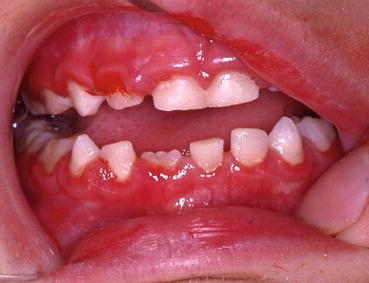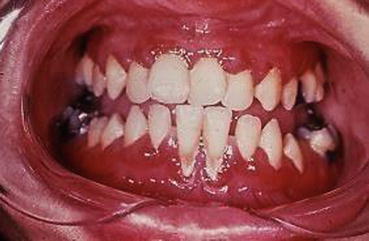and Angela J. Yoon1
(1)
Columbia University College of Dental Medicine and Department of Pathology and Cell Biology, Columbia University Medical Center, New York, NY, USA
Hematologic disorders may exhibit nonspecific as well as pathognomonic oral manifestations.
10.1 White Blood Cell Disorders
Cyclic neutropenia (Cyclic hematopoiesis)
Cyclic neutropenia most commonly presents in infants and children. Patients typically experience cyclically recurrent episodes of fever, ear infections, sore throat, oral ulcerations, and skin infections. These manifestations correspond with a transient neutropenia that occurs at intervals of 15–35 days (most commonly 21 days). Oral manifestations of cyclic neutropenia include recurrent aphthous stomatitis, recurrent gingivitis, and periodontitis. Oral lesions occur during the nadir and resolves spontaneously as the neutrophil count improves.

Fig. 10.1
Gingivitis. Inflamed gingiva in a child with cyclic neutropenia

Fig. 10.2
Gingivitis and marked localized recession in an adolescent with cyclic neutropenia

Fig. 10.3
Inflamed gingiva and a major aphthous-like ulceration of the lower lip mucosa
Leukemia
Clinical manifestations of leukemia results from loss of normal leukocyte function, suppression of hematopoietic cell lines, or direct infiltration of leukemic cells into tissues. Systemic signs and symptoms include fatigue, anemia, lymphadenopathy, recurrent infection, bone and abdominal pain, bleeding, and purpura. Oral manifestations include mucosal, gingival bleeding and mucosal petechiae, and oral ulcerations. Patients are also susceptible to severe viral, fungal, and bacterial oral infections as a consequence of immunosuppression. A leukemic infiltrate of the gingiva presents as swollen, erythematous, and friable gingiva.
Stay updated, free dental videos. Join our Telegram channel

VIDEdental - Online dental courses


